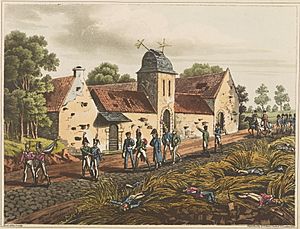Mont-Saint-Jean, Belgium facts for kids
Mont-Saint-Jean is a small village, also called a hamlet. It is located in Wallonia, a region in Belgium. You can find it in the province of Walloon Brabant.
Mont-Saint-Jean is just south of Waterloo. It sits partly in Waterloo and partly in another town called Braine-l'Alleud. Two main roads cross here: the N5, which goes from Brussels to Charleroi, and the N234, which connects Nivelles to Leuven.
History of Mont-Saint-Jean
Mont-Saint-Jean is famous because of the Battle of Waterloo. This big battle happened on a sloping hill, and Mont-Saint-Jean was on the other side of that slope. In fact, Napoleon Bonaparte himself called the battle "the Battle of Mont-Saint-Jean."
During the battle, there was a farm called Mont-Saint-Jean Farm. It was located right on the main road between Charleroi and Brussels. This farm was very important.
Mont-Saint-Jean Farm as a Hospital
Many buildings near the battle, including Mont-Saint-Jean Farm, were used as hospitals. They helped soldiers who were hurt during the fighting.
After the battle, the Duke of Wellington, who led the British forces, quickly went to Brussels. He asked the people there for help. He needed them to collect the wounded soldiers and bury those who had died. He also wanted to calm everyone down, as there was a lot of worry in Belgium.
The people of Brussels responded bravely. Church leaders were among the first to help the injured soldiers. People from all walks of life, even those of high rank, worked hard to care for the many wounded heroes. These brave soldiers filled hospitals and even private homes.
Mont-Saint-Jean in Les Misérables
Mont-Saint-Jean is also mentioned in a famous book. The novel Les Misérables was written by Victor Hugo.
In the book, a chapter called "The Plateau of Mont-Saint-Jean" describes a key part of the battle. It talks about how French cavalry (soldiers on horseback) bravely attacked the British infantry. The British soldiers formed squares to defend themselves on the hillside near Mont-Saint-Jean.



